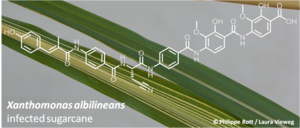Hope for new Antibiotics

21 January 2015
A German-French research team solves the structural paradigm of albicidin – funding provided by the TU Excellence Cluster "UniCat", published in "Nature Chemical Biology"
After 30 years, scientists of TU Berlin and the CIRAD Institute finally unraveled the mystery about the structure of albicidin, a highly potent antibiotic and pathogenicity factor. This paves the way for further research in the search for new antibiotics effective against resistant bacteria.
In 1985, albicidin was first described by an U.S. American and Australian team of scientists, who researched sugarcane. They were able to prove that the bacterium xanthomonas albilineans affects sugarcanes and by releasing the metabolite albicidin, it causes pencil lines to develop, which is a disease of the sugarcane that leads to the death of the plant (sugarcane leaf scald disease). First the plant develops the characteristic white lines on its leaves, followed by the subsequent death. This infection with the pathogen xanthomonas albilineans is the most frequent bacterial disease of sugarcane. The cultivation of sugarcane which is highly prone to this disease is facing today a steadily rising worldwide demand. In 2012 alone, 1.8 billion tons of sugarcane was cultivated to produce sugar and bioethanol.
In addition to leaf scald, albicidin's highly antibacterial activity, particularly against gram-negative bacteria is yet another attribute that has fascinated researchers for the past decades. Even though there were no profound structural data about albicidin available, products containing albicidin were highly bioactive against a large number of human pathogens, i.e. those pathogens that cause disease in humans. Albicidin is able to inhibit replication of bacterial DNA through a novel mechanism that is quite different from traditional antibiotics of the same class and therefore, it is significantly more potent. However, the in-depth knowledge about the molecular structure required to use this attribute in humans was still missing.
Use to fight infections caused by gram-negative bacteria
Thirty years, after albicidin has first been described, the research team led by Prof. Dr. Roderich Süssmuth from TU Berlin together with Dr. Monique Royer and Dr. Stéphane Cociancich from the CIRAD Institute in Montpellier succeeded in elucidating its chemical structure: albicidin is a rather extraordinary linear acyl peptide with a remarkable pattern of atypical aromatic, non-proteinogenic amino acids. Additional biosynthetic analyses were able to substantiate and demonstrate further that not only the molecular structure of albicidin but also its biosynthesis in xanthomonas albilineans is so far unique (Nature Chemical Biology, 2014). In addition, the researchers were able to describe this not so trivial chemical syntheses of this complex molecule in a follow-up publication (Angewandte Chemie International Edition, 2014), which will provide the foundation for further research on albicidin. Furthermore, they showed that is able to bypass common antibiotic resistances and it demonstrates an unchanged activity against quinolone-resistant Escherichia coli strains. This is particularly important because quinolones has multiple medical applications as broad spectrum antibiotic such as to treat anthrax. However, resistances occur more frequently, a circumstance which increases additionally the need for new antibiotics with a similar range of effects.
These results are the product of a close interdisciplinary cooperation between plant physiologists and synthesis chemists as well as molecular biologists. “It shows that it is worthwhile to work on difficult and complex problems several years intensively and at full speed”, says Prof. Dr. Roderich Süssmuth. “We would have been unable to work on this project successfully without funding provided by the German Excellence Cluster ‘UniCat’ at TU Berlin and the French ANR.” Standard funding through a DFG (German Research Foundation) project usually runs out after two years. Researchers have filed a comprehensive patent for further potential commercial use. “Not only TU Berlin would benefit from the commercial aspects of patent use but it would seem to be a moral obligation to drive forward the development of the active substance in today’s desperate need for new antibiotics” says Professor Süssmuth. “However, such a project can be extremely challenging due to the massive hurdles of active substance development.”
The newly acquired knowledge about albicidin should be used in the future not only to understand better leaf scald in sugarcane but also to use the new guiding structure of albicidin to develop a new active substance to fight infections caused by gram-negative bacteria.
The Cluster of Excellence "Unifying Concepts in Catalysis" (UniCat)
UniCat is an interdisciplinary research network, established as part of the Excellence Initiative of the German Federal and State Governments. Its central theme is catalysis. UniCat is supported by four universities and two Max Planck Institutes in Berlin and Potsdam. About 50 working groups collaborate across disciplines on research topics relevant to the future of raw material change and energy turnaround: from the chemical conversion of methane to ethylene, the chemical and enzymatic activation of carbon dioxide through the catalytic production of hydrogen from water using sunlight as an energy source, to the synthesis of drugs with the help of artificial enzymes. The Technische Universität Berlin (TU Berlin) is the host University.
For the original publication, go to the following page:
www.nature.com/nchembio/journal/vaop/ncurrent/full/nchembio.1734.html
Nature Chemical Biology (2015), DOI:10.1038/nchembio.1734
For further information, please contact:
Prof. Dr. Roderich Süssmuth
TU Berlin, Faculty II Mathematics and Natural Sciences, Institute of Chemistry
Departement of Organic Chemistry, Chair of Synthetic Biotechnology and Antibiotics
Tel.: +49 (0)30 314-78774
E-mail: suessmuth(at)chem.tu-berlin.de
